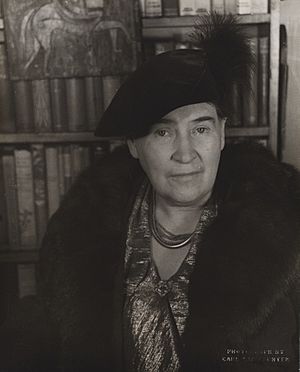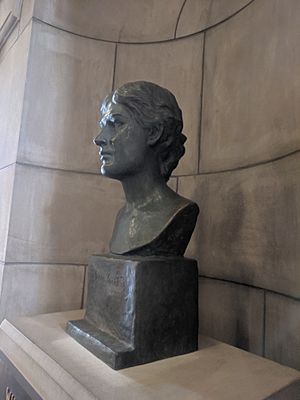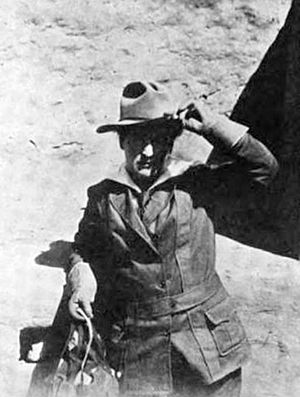Willa Cather facts for kids
Quick facts for kids
Willa Cather
|
|
|---|---|

Cather in 1936
|
|
| Born | Wilella Sibert Cather December 7, 1873 Gore, Virginia, U.S. |
| Died | April 24, 1947 (aged 73) New York City, U.S. |
| Resting place | Jaffrey, New Hampshire, U.S. |
| Occupation | Novelist |
| Period | 1905–1947 |
| Partner | Edith Lewis (c. 1908–1947) |
| Signature | |
Willa Sibert Cather (born Wilella Sibert Cather; December 7, 1873 – April 24, 1947) was an American writer. She is famous for her novels about life on the Great Plains. Some of her well-known books include O Pioneers!, The Song of the Lark, and My Ántonia. In 1923, she won the Pulitzer Prize for her novel One of Ours, which was set during World War I.
Willa Cather and her family moved from Virginia to Nebraska when she was nine years old. They later settled in a town called Red Cloud. After graduating from the University of Nebraska–Lincoln, Cather lived in Pittsburgh for ten years. There, she worked as a magazine editor and a high school English teacher. At age 33, she moved to New York City, which became her main home. She also traveled a lot and spent time at her summer home in New Brunswick. She lived with her partner, Edith Lewis, for 39 years. Willa Cather passed away in 1947. Edith Lewis is buried next to her.
Cather became known for her novels about the frontier and pioneer experience. She wrote about the spirit of settlers moving into the western states. Many of these settlers were European immigrants in the 1800s. Her stories often explored themes like missing the past and feeling like an outsider. The "sense of place" was very important in her writing. Landscapes and homes were like living characters in her stories. Her characters often struggled against these places and found community there.
Contents
Early Life and Education

Growing Up in Virginia
Willa Cather was born in 1873 on her grandmother's farm in Virginia. Her father was Charles Fectigue Cather. Her mother was Mary Virginia Boak, a former teacher. When Willa was one year old, her family moved to a large home called Willow Shade. This home was on 130 acres of land given to them by her grandparents.
Willa had six younger brothers and sisters. She was closer to her brothers than to her sisters.
Moving to Nebraska
In 1883, when Willa was nine, her family moved to Nebraska. Her father's parents wanted them to move there. The farmland was good for Charles's father. Also, the family wanted to escape sickness that was common in Virginia. Willa's father tried farming for 18 months. Then, he moved the family to the town of Red Cloud. There, he started a real estate business. The children also went to school for the first time.
Some of Cather's first writings were published in the local paper, the Red Cloud Chief. She loved to read and became friends with a Jewish couple, the Wieners. They let her use their large library in Red Cloud. For a short time, she even signed her name as William. She also helped the local doctor and thought about becoming a surgeon.
College Years
In 1890, at age 16, Cather finished Red Cloud High School. She then moved to Lincoln, Nebraska to attend the University of Nebraska–Lincoln. In her first year, an essay she wrote was published in a newspaper without her knowing. After that, she started writing columns for money. Seeing her words in print made her want to keep writing. She became a regular writer for the Nebraska State Journal.
Cather also edited the university's student newspaper, The Hesperian. She wrote for another local paper, the Lincoln Courier. While at college, she learned math from John J. Pershing. He later became a famous general and also won a Pulitzer Prize for his writing. Cather changed her plans from studying science to becoming a doctor. Instead, she graduated in 1895 with a degree in English.
Her time in Nebraska was very important for her writing. She was inspired by the dramatic weather and the huge prairie. She also learned about the many cultures of the immigrant and Native American families there.
Life and Career as a Writer
Early Career in Pittsburgh
In 1896, Cather moved to Pittsburgh to write for a women's magazine called Home Monthly. She wrote articles, short stories, and poems there. A year later, she became an editor and critic for the Pittsburgh Leader. She also wrote for The Library, another local paper. In Pittsburgh, she taught Latin, algebra, and English at Central High School. Later, she taught English and Latin at Allegheny High School, where she became head of the English department.
Soon after moving to Pittsburgh, Cather wrote short stories. One was "Tommy, the Unsentimental". It was about a girl in Nebraska who looked like a boy and saved her father's bank. Her first book of poems, April Twilights, came out in 1903. In 1905, her first collection of short stories, The Troll Garden, was published. It included famous stories like "A Wagner Matinee" and "Paul's Case".
Moving to New York and Famous Novels
In 1906, Cather was offered an editing job at McClure's Magazine. She then moved to New York City. McClure's published her first novel, Alexander's Bridge (1912). While many reviews were good, Cather herself felt the novel was not strong enough.
After this, Cather wrote three novels set in the Great Plains. These books became very popular and were praised by critics. They are O Pioneers! (1913), The Song of the Lark (1915), and My Ántonia (1918). These three books are sometimes called her "Prairie Trilogy." Cather was celebrated for using simple language to write about everyday people in these stories. Famous writers like Sinclair Lewis and F. Scott Fitzgerald admired her work.
Success in the 1920s
By 1920, Cather changed publishers to Alfred A. Knopf. She liked how they supported their authors and made their books look good.
Cather became a very important American writer. She won the Pulitzer Prize in 1923 for her World War I novel, One of Ours. She then wrote Death Comes for the Archbishop in 1927, which sold many copies. This book is still considered one of the best novels of the 20th century. Her other novels from this time, A Lost Lady and The Professor's House, also greatly increased her fame. She gave many public talks and earned good money from her books.
Even with her success, some critics did not like her work. They felt her portrayal of war in One of Ours was not realistic.
The 1930s and Later Works
By the 1930s, some critics thought Cather's writing was too old-fashioned. They felt she focused too much on the past and did not deal with current problems. This was especially true during the Great Depression, when her work was seen as not relevant to social issues.
Despite this, Cather remained a popular writer. Her novels and short stories continued to sell well. In 1931, Shadows on the Rock was the most widely read novel in the United States. Lucy Gayheart also became a bestseller in 1935.
Cather made her last trip to Red Cloud in 1931 after her mother passed away. She stayed in touch with friends there and sent money to families during the Depression. In 1932, Cather published Obscure Destinies, her last collection of short stories. It included "Neighbour Rosicky", one of her most loved stories. She was elected to the American Philosophical Society in 1934.
In 1938, Cather faced two sad losses. Her favorite brother, Douglass, passed away. A few months later, her close friend Isabelle McClung also died. Cather had lived with Isabelle when she first moved to Pittsburgh. Cather wrote that Isabelle was the person for whom she wrote all her books.
Final Years and Legacy
In the summer of 1940, Cather finished her last novel, Sapphira and the Slave Girl. This book was darker than her previous works. It was a big success with both critics and readers. Her last story, "The Best Years", was a gift for her brother. It looked back at images from her past novels and stories.
Even though a problem with her hand made writing difficult, Cather started a new novel. It was set in France in the 14th century. She called it Hard Punishments. In 1943, she was elected a fellow of the American Academy of Arts and Sciences. The next year, she received a gold medal for fiction. This was a major award for all her writing achievements.
Willa Cather passed away on April 24, 1947, at age 73. She is buried in Jaffrey, New Hampshire. Her partner, Edith Lewis, was buried beside her 25 years later. Cather had asked that her personal letters not be published and her works not be made into plays. However, some of her letters were published in 2013. These letters showed more about her complex character and inner world.
Willa Cather's Personal Life
Throughout her adult life, Willa Cather's closest companions were women. These included her college friend Louise Pound and Pittsburgh socialite Isabelle McClung. Cather traveled to Europe with Isabelle and stayed at her home often. She was also close with opera singer Olive Fremstad. Most importantly, she lived with editor Edith Lewis for the last 39 years of her life.
Cather and Lewis lived together in New York City from 1908 until Cather's death in 1947. Edith Lewis was not just a helper for Cather's papers. She was a very important part of Cather's creative process.
Starting in 1922, Cather spent her summers on Grand Manan island in New Brunswick. She bought a cottage there. Her short story, "Before Breakfast", is set on this island. She liked the quietness of the island. Her cottage did not even have indoor plumbing or electricity. She stopped visiting Grand Manan in 1940 because of World War II and health issues.
Cather was a very private person. She destroyed many of her drafts, personal papers, and letters. She also asked others to do the same. While many followed her wishes, some did not. Her will limited what scholars could quote from her remaining personal papers. However, a collection of 566 of her letters was published in 2013. The Willa Cather Archive at the University of Nebraska–Lincoln is working to make all her writings, including letters, available online.
What Influenced Willa Cather's Writing
Cather admired writer Henry James for his language and characters. While she enjoyed novels by some women writers like George Eliot, she often thought most women writers were too emotional. One exception was Sarah Orne Jewett, who became Cather's friend and mentor. Jewett advised Cather to write about her "own country" and to use female narrators.
Cather deeply respected the immigrant families who built lives on the Nebraska plains. Their struggles and strength shaped much of her fiction. The train station in Red Cloud brought many different people to her small town. As a child, she visited immigrant families. She felt excited, as if she "had got inside another person's skin." After a trip to Red Cloud in 1916, Cather decided to write a novel based on her childhood friend Annie Sadilek Pavelka. Annie became the model for the main character in My Ántonia. Cather was also interested in the French-Canadian pioneers who had settled near Red Cloud.
During a short visit to Quebec with Edith Lewis in 1927, Cather was inspired to write a novel set in that French-Canadian city. Lewis remembered that Cather was "overwhelmed" by the city's French character. Cather finished her novel Shadows on the Rock, a historical story set in 17th-century Quebec, in 1931. This book was later listed as one of the 100 outstanding books of 1924–1944 by Life magazine. French influences can also be found in other Cather works, like Death Comes for the Archbishop (1927) and her last, unfinished novel, Hard Punishments.
See also
 In Spanish: Willa Cather para niños
In Spanish: Willa Cather para niños



